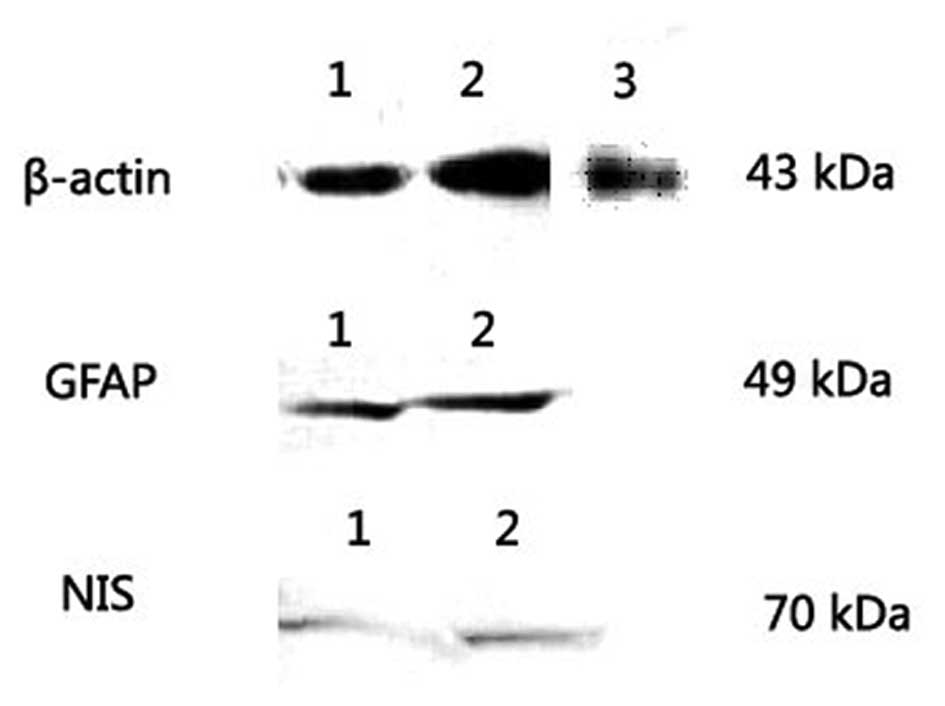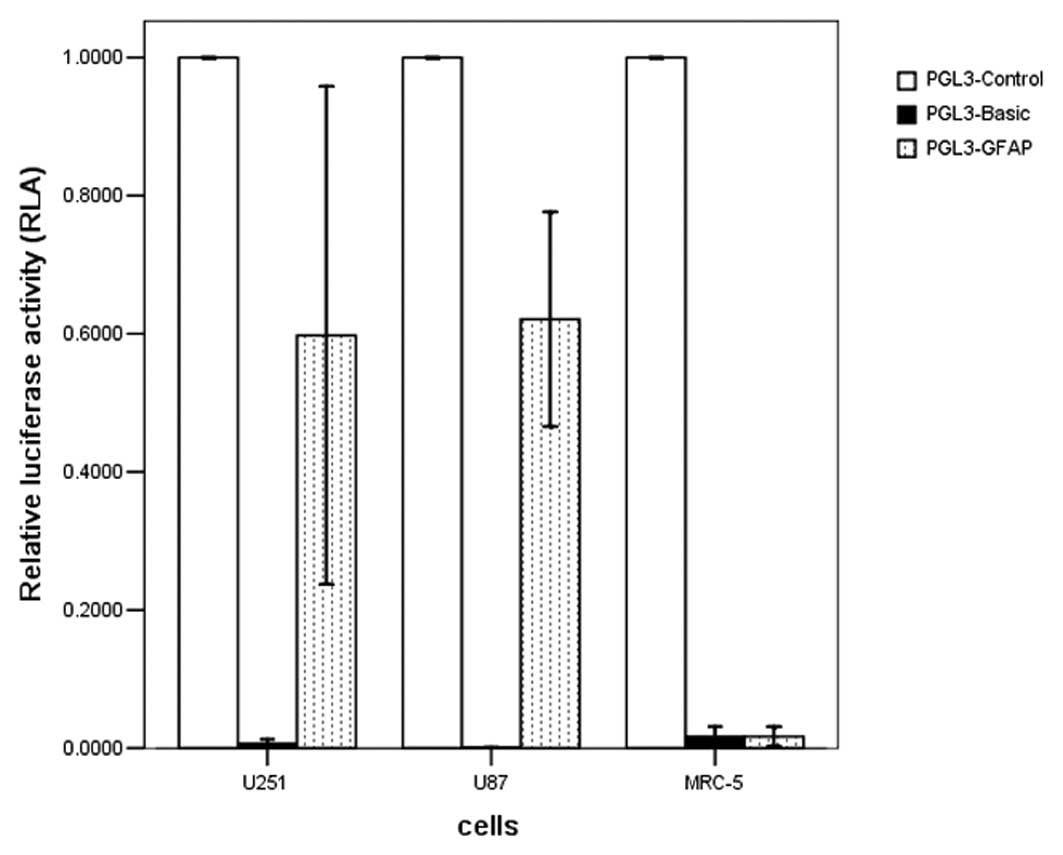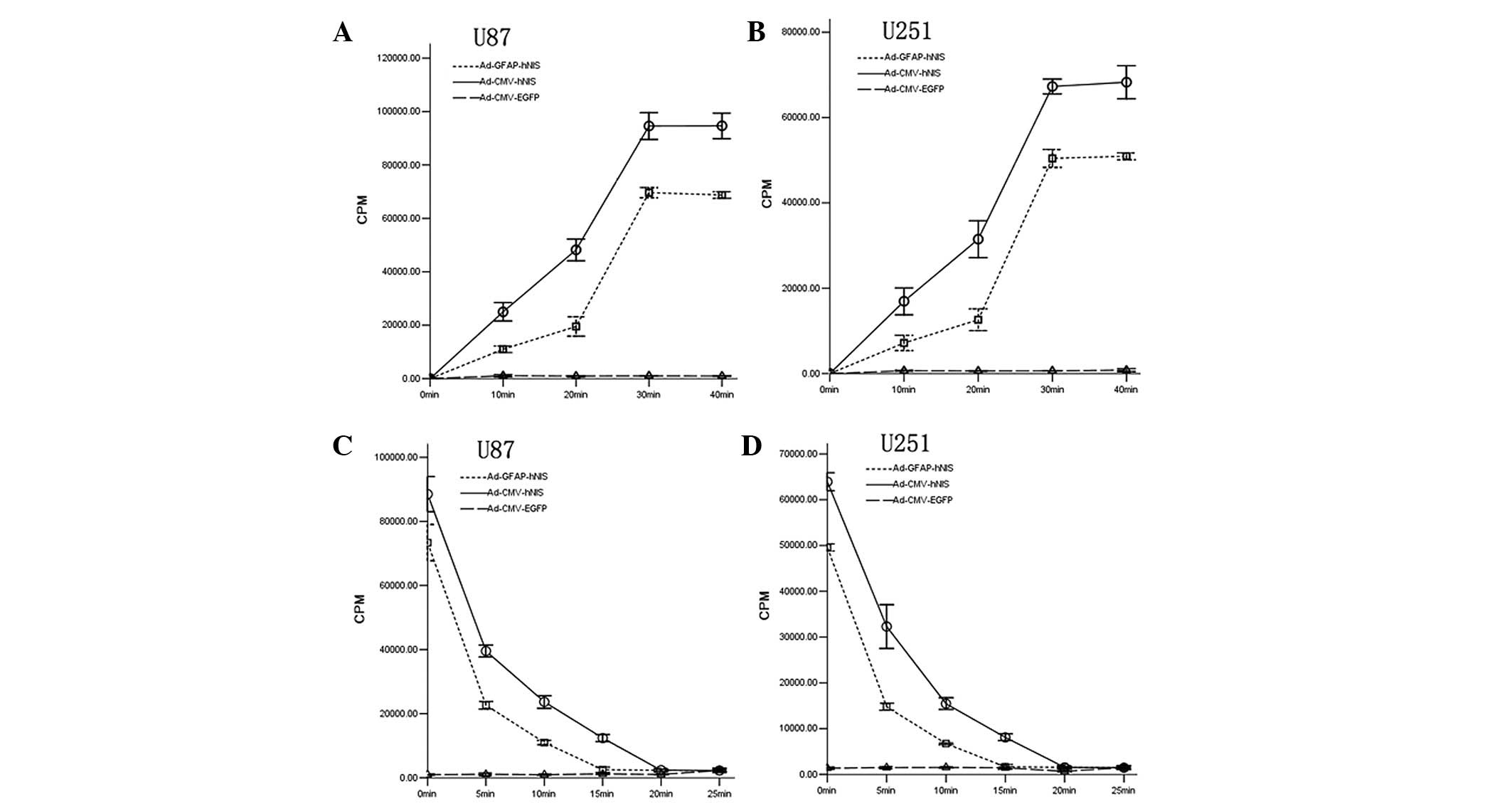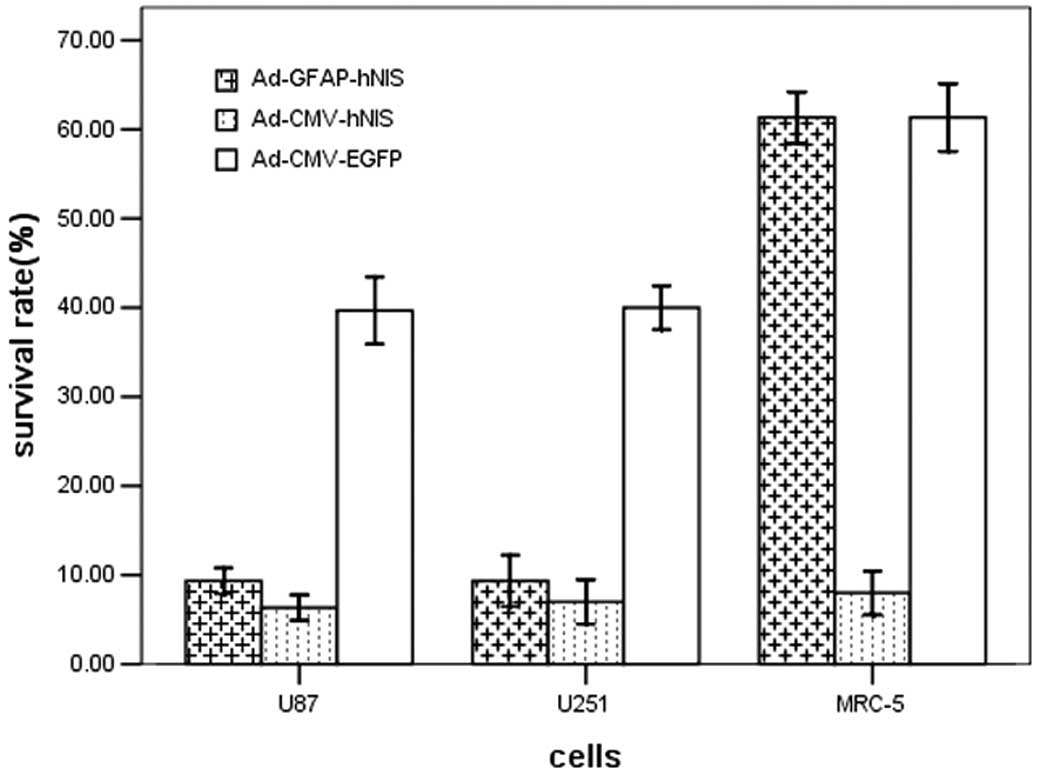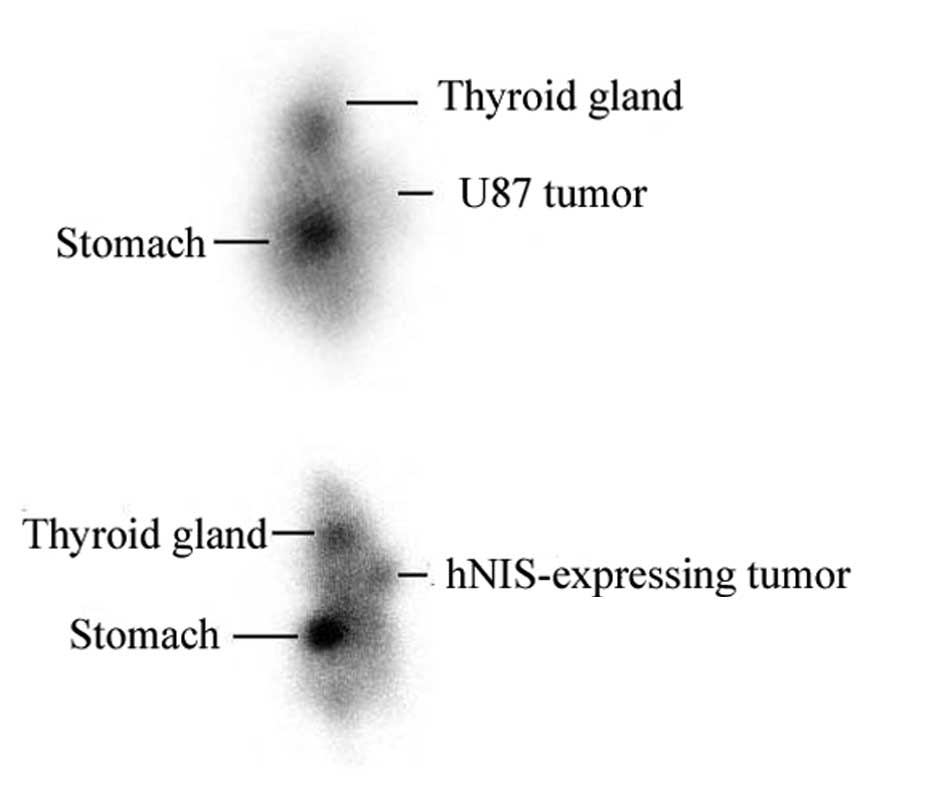|
1.
|
Vredenburgh JJ, Desjardins A, Reardon DA
and Friedman HS: Experience with irinotecan for the treatment of
malignant glioma. Neuro Oncol. 11:80–91. 2009. View Article : Google Scholar : PubMed/NCBI
|
|
2.
|
Li W, Tan J, Wang P and Wu P:
Cotransfected sodium iodide symporter and human tyroperoxidase
genes following human telomerase reverse transcriptase promoter for
targeted radio-iodine therapy of malignant glioma cells. Cancer
Biother Radiopharm. 26:443–451. 2011. View Article : Google Scholar
|
|
3.
|
Gu J, Kagawa S, Takakura M, Kyo S, Inoue
M, Roth JA and Fang B: Tumor-specific transgene expression from the
human telomerase reverse transcriptase promoter enables targeting
of the therapeutic effects of the Bax gene to cancers. Cancer Res.
60:5359–5364. 2000.
|
|
4.
|
Brenner M, Kisseberth WC, Su Y, Besnard F
and Messing A: GFAP promoter directs astrocyte-specific expression
in transgenic mice. J Neurosci. 14:1030–1037. 1994.PubMed/NCBI
|
|
5.
|
Nolte C, Matyash M, Pivneva T, Schipke CG,
Ohlemeyer C, Hanisch UK, Kirchhoff F and Kettenmann H: GFAP
promoter-controlled EGFP-expressing transgenic mice: a tool to
visualize astrocytes and astrogliosis in living brain tissue. Glia.
33:72–86. 2001. View Article : Google Scholar : PubMed/NCBI
|
|
6.
|
Besnard F, Brenner M, Nakatani Y, Chao R,
Purohit HJ and Freese E: Multiple interacting sites regulate
astrocyte-specific transcription of the human gene for glial
fibrillary acidic protein. J Biol Chem. 266:18877–18883. 1991.
|
|
7.
|
Yang N and Mahato RI: GFAP promoter-driven
RNA interference on TGF-β1 to treat liver fibrosis. Pharm Res.
28:752–761. 2011.PubMed/NCBI
|
|
8.
|
Giralt A, Friedman HC, Caneda-Ferrón B,
Urban N, Moreno E, Rubio N, Blanco J, Peterson A, Canals JM and
Alberch J: BDNF regulation under GFAP promoter provides engineered
astrocytes as a new approach for long-term protection in
Huntington’s disease. Gene Ther. 17:1294–1308. 2010.PubMed/NCBI
|
|
9.
|
Huang J, Gao J, Lv X, Li G, Hao D, Yao X,
Zhou L, Liu D and Wang R: Target gene therapy of glioma:
overexpression of BAX gene under the control of both
tissue-specific promoter and hypoxia-inducible element. Acta
Biochim Biophys Sin (Shanghai). 42:274–280. 2010. View Article : Google Scholar : PubMed/NCBI
|
|
10.
|
Hede SM, Hansson I, Afink GB, Eriksson A,
Nazarenko I, Andrae J, Genove G, Westermark B and Nistér M: GFAP
promoter driven transgenic expression of PDGFB in the mouse brain
leads to glioblastoma in a Trp53 null background. Glia.
57:1143–1153. 2009. View Article : Google Scholar : PubMed/NCBI
|
|
11.
|
Chen L, Altmann A, Mier W, Eskerski H,
Leotta K, Guo L, Zhu R and Haberkorn U: Radioiodine therapy of
hepatoma using targeted transfer of the human sodium/iodide
symporter gene. J Nucl Med. 47:854–862. 2006.PubMed/NCBI
|
|
12.
|
Spitzweg C, Zhang S, Bergert ER, Castro
MR, McIver B, Heufelder AE, Tindall DJ, Young CY and Morris JC:
Prostate-specific antigen (PSA) promoter-driven androgen-inducible
expression of sodium iodide symporter in prostate cancer cell
lines. Cancer Res. 59:2136–2141. 1999.PubMed/NCBI
|
|
13.
|
Boland A, Ricard M, Opolon P, Bidart J,
Yeh P, Filetti S, Schlumberger M and Perricaudet M:
Adenovirus-mediated transfer of the thyroid sodium/iodide symporter
gene into tumors for a targeted radiotherapy. Cancer Res.
60:3484–3492. 2000.PubMed/NCBI
|
|
14.
|
Schipper M, Weber A, Béhé M, Göke R, Joba
W, Schmidt H, Bert T, Simon B, Arnold R, Heufelder A and Behr T:
Radioiodide treatment after sodium iodide symporter gene transfer
is a highly effective therapy in neuroendocrine tumor cells. Cancer
Res. 63:1333–1338. 2003.PubMed/NCBI
|
|
15.
|
Ma XJ, Huang R and Kuang AR: AFP promoter
enhancer increased specific expression of the human sodium iodide
symporter (hNIS) for targeted radioiodine therapy of
hepato-cellular carcinoma. Cancer Invest. 27:673–681. 2009.
View Article : Google Scholar
|
|
16.
|
Scholz IV, Cengic N, Baker CH, Harrington
KJ, Maletz K, Bergert ER, Vile R, Göke B, Morris JC and Spitzweg C:
Radioiodine therapy of colon cancer following tissue-specific
sodium iodide symporter gene transfer. Gene Ther. 12:272–280. 2005.
View Article : Google Scholar : PubMed/NCBI
|
|
17.
|
Spitzweg C, Baker CH, Bergert ER, O’Connor
MK and Morris JC: Image-guided radioiodide therapy of medullary
thyroid cancer after carcinoembryonic antigen promoter-targeted
sodium iodide symporter gene expression. Hum Gene Ther. 18:916–924.
2007. View Article : Google Scholar
|
|
18.
|
Kim HJ, Jeon YH, Kang JH, Lee YJ, Kim KI,
Chung HK, Jeong JM, Lee DS, Lee MC and Chung JK: In vivo long-term
imaging and radioiodine therapy by sodium-iodide symporter gene
expression using a lentiviral system containing ubiquitin C
promoter. Cancer Biol Ther. 6:1130–1135. 2007. View Article : Google Scholar : PubMed/NCBI
|
|
19.
|
Sieger S, Jiang S, Schönsiegel F, Eskerski
H, Kübler W, Altmann A and Haberkorn U: Tumour-specific activation
of the sodium/iodide symporter gene under control of the glucose
transporter gene 1 promoter (GTI-1.3). Eur J Nucl Med Mol Imaging.
30:748–756. 2003. View Article : Google Scholar : PubMed/NCBI
|
|
20.
|
Doloff JC, Jounaidi Y and Waxman DJ: Dual
E1A oncolytic adenovirus: targeting tumor heterogeneity with two
independent cancer-specific promoter elements, DF3/MUC1 and hTERT.
Cancer Gene Ther. 18:153–166. 2011. View Article : Google Scholar : PubMed/NCBI
|
|
21.
|
Löw K, Blesch A, Herrmann J and Tuszynski
MH: A dual promoter lentiviral vector for the in vivo evaluation of
gene therapeutic approaches to axon regeneration after spinal cord
injury. Gene Ther. 17:577–591. 2010.PubMed/NCBI
|















